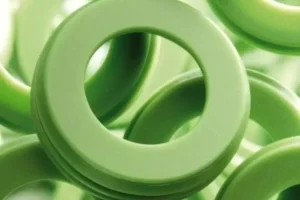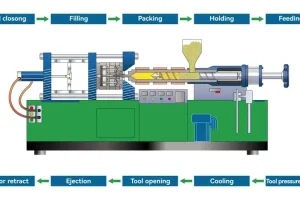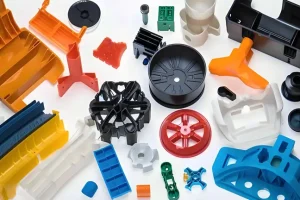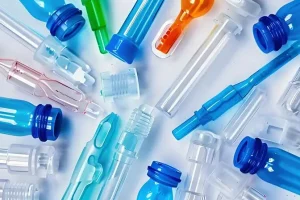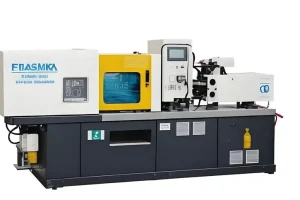Introduction: In the ever-changing world of manufacturing, injection molding is a game-changer that has revolutionized the way we make complex and precise plastic parts. It’s a big deal in many industries because it’s a cheap way to make a lot of stuff.

As we dive into the world of injection molding, it’s important to understand why it’s so important and how it’s changing the way we make things. Let’s start by understanding the basics of the plastic injection molding process.

What is the Definition and Principle of Plastic Injection Molding?
Plastic injection molding is a process where you heat up plastic, push it forward through the screw of an injection machine, and then inject it into a mold where it cools and forms. The basic idea is to heat and melt the plastic, then inject it into the mold under pressure, let it cool and solidify in the mold, and finally make plastic products.

It can not only make high-precision, high-quality products with high productivity, but also can process many types of plastics and has a wide range of uses. Therefore, injection molding is one of the important molding methods in plastic processing.

What are the Plastic Injection Molding Processes?
Prepare Ingredients
The raw material for plastic injection molding is plastic pellets, which need to be put into the plastic injection machine for heating and melting. When preparing raw materials, we need to consider the quality of the pellets and the gas content to ensure the quality of the molded product.

Mechanical Equipment
Plastic injection molding requires the use of equipment such as plastic injection machines, among which plastic injection machines are key equipment and mainly include feeding systems, heating systems, pressure systems, etc. Equipment needs to be inspected and maintained before use to ensure it can operate properly.

Assembly of Injection Mold
Connect the mold to the plastic injection machine, then inject lubricating oil into the mold to make the surface smooth. Heat the mold to the right temperature to make the plastic flow better.

Plastic Melting
Put the plastic particles into the feeding system of the plastic injection machine, then heat them up and melt them into liquid plastic.

Injection Molding
Inject the molten plastic into the mold through the pressure system of the plastic injection machine. After the plastic cools down, take the product out of the mold and the molding is done.

Quality Inspection
Check the finished products to make sure their size, appearance, strength, etc. meet the requirements. For the unqualified products, adjust the production process to improve the quality.

What are the Advantages of Plastic Injection Molding?
Efficient and High Precision
Plastic injection molding is a technology that enables efficient, high-precision production. Injection molding technology allows for the production of large quantities of products in a short amount of time. Additionally, because injection molding is done in a closed mold, the accuracy and dimensional stability of the finished product can be guaranteed.

High Productivity
Plastic injection molding technology has very high production efficiency. Injection molding machines can achieve continuous production and can be automated, reducing manual intervention. In some mass production situations, injection molding technology can achieve higher production efficiency than other molding technologies.

Material Diversity
Plastic injection molding technology can be used to mold a variety of materials, including polypropylene, polystyrene, polycarbonate, and other materials. Different material selections and adjustments can be made to optimize product performance.

Injection Molding Enables Complex Part Designs
Injection molding can handle highly complex parts, provides consistency, and offers the ability to manufacture millions of nearly identical parts. The effectiveness of high-volume injection molding and maximizing part accuracy and quality means taking critical design elements into consideration.

Part design must maximize the efficiencies inherent in high-volume molding. With an ideal design, parts can be manufactured with high quality without sacrificing complexity.

Plastic is Stronger
Plastics have gotten a lot stronger over the years. Modern lightweight thermoplastics can take a beating in harsh environments just as well as, and sometimes better than, metal parts.

Plus, there are over 25,000 engineering materials to choose from for complex injection molding jobs. You can also make high-performance plastic blends and hybrids to meet specific part requirements and properties, like high tensile strength.

Injection Molding Can Reduce Waste
Compared to traditional manufacturing processes, plastic injection molding processes produce very little post-production waste. Any waste plastic usually comes from gates and runners. However, any unused or discarded plastic can be reground and recycled for future use.

Injection Molding Offers a Variety of Surfaces
Most injection molded parts have a smooth surface finish that is close to the desired final appearance. However, the smooth appearance is not suitable for all applications. Depending on the physical and chemical properties of the plastic material used, the plastic injection molding manufacturing process creates a surface finish that does not require secondary operations. The process offers flexibility in surface treatments, from matte surfaces and unique textures to engraving.

Shaping Creates Lightweight Products
Although they are most common in the automotive industry, original equipment manufacturers use lightweight plastic injection molded products in many industries. Using plastic parts helps reduce weight compared to using metal parts. Today, high-strength, lightweight thermoplastics can replace metal parts with little difference in strength or durability, just weight.

Injection Molding has Consistency
To make a lot of complicated plastic parts, you need to do the same thing over and over again to make sure they all come out the same. That’s why we use the same mold for every part and keep making it better with the newest machines and technology.

Injection Molding Can Create Precision Products
If you take care of it, modern high-speed injection molding machines can make a lot of precision molded plastic parts. This is the best way to make plastic parts like connectors and gears that have to be made really precisely, with tolerances as tight as +/-0.0002 inches.

Plastic injection molding is a widely used technology because it’s fast, accurate, versatile, and easy to use. You can use it to make all kinds of plastic stuff, like things you use every day, parts for electronics, and parts for cars.

What are the Limitations of Plastic Injection Molding?
Long Molding Cycle
Plastic injection molding is a long process that involves making molds and injecting them with plastic. It takes a long time to complete the entire process, especially for complex products that require multiple injections. This increases the time it takes to make the molds. This is not good for customers who need their products quickly.

It’s Expensive
Plastic injection molding requires multiple mold trials and mold making, which increases the cost. This is especially true for small batches of custom products. Also, injection molding machines and molds are expensive. This makes it hard for small and medium-sized businesses to get into the industry.

It’s Bad for the Environment
Plastic injection molding uses a lot of plastic, which increases the risk of pollution. This is especially true for plastic waste that doesn’t get recycled. This is bad for the environment. Also, the process of plastic injection molding creates waste gas and waste water, which pollutes the environment.

Product Performance Limitations
There are some limitations to the materials used in plastic injection molding. They can’t produce products with high strength, high heat resistance, high corrosion resistance, and other characteristics. There are also limitations on the appearance of the product.It’s difficult to produce products with complex shapes.

Design Constraints
Certain design elements can create challenges during the injection molding process. Features such as undercuts, sharp corners, or intricate details can complicate the injection molding cycle of a design and impact the overall viability of the manufacturing process.

What are the Commonly Used Materials for Injection Molding?
The materials we choose aren’t random; they’re strategic decisions based on what we’re trying to do. Whether it’s the clarity of polycarbonate in optical components or the wear resistance of nylon in mechanical components, each material plays a vital role in the success of the injection molding process.

Polypropylene (PP)
Polypropylene is the second most common plastic in the world. It has a high melting point and high chemical resistance. It retains its shape after twisting or bending and doesn’t deteriorate when exposed to moisture or water. PP, commonly known as injection molded polypropylene, is a recycled material.

Despite its many advantages, polypropylene is flammable and UV-sensitive. This injection molded plastic decomposes at temperatures above 100°C, producing dangerous aromatic hydrocarbons. Polypropylene plastic is difficult to paint and adhere to.

Polypropylene is used in a variety of products, including toys, containers, sporting goods, packaging, equipment and power tool bodies.

Acrylonitrile Butadiene Styrene (ABS)
ABS is a plastic that is easy to shape because it has a low melting point. It is opaque, which makes it easy to use with colorants and to create different textures and surface treatments.

ABS is known for being durable and resistant to impact. However, it is not very resistant to sunlight, water, or weather. Injection molded ABS is not suitable for outdoor applications when compared to acrylic.

Injection molded ABS plastic is used to make keyboards, helmets, wall panels for power outlets, dashboards, wheel covers, and other vehicle parts.

Polycarbonate (PC)
Polycarbonate is a lightweight, strong, and naturally transparent material. It has consistent physical properties over a wide temperature range.

Polycarbonate has uniform and predictable shrinkage, which allows for good dimensional control and tighter tolerances. It is not scratch resistant, but it is stronger and tougher than glass.
Polycarbonate
Polycarbonate plastic is used to make machine guards, clear and colored windows, diffusers and light guides for LEDs, and clear tubing. It can also be used to make clear molds for silicone and polyurethane molding.

Polyethylene (PE)
Polyethylene is the most widely used plastic in the world. It is a commercial polymer that can be selected based on density. High-density polyethylene and low-density polyethylene are both chemical resistant, but they differ in stiffness, flexibility, melting points, and optical clarity.

Injection molded polyethylene is used in household appliances, toys, food containers, and automotive parts.
Polystyrene (PS)
Polystyrene plastic is lightweight, inexpensive, and resistant to moisture and bacterial growth. The two most common types are general purpose polystyrene and high impact polystyrene.

Polystyrene.
Also, these common polymers are resistant to gamma radiation and have high chemical resistance to dilute acids and alkalis, both of which are used in the sterilization of medical devices.

Polystyrene is used in medical, optical, electrical and electronic applications. Because of its improved impact strength, HIPS is widely used in machinery and equipment. Injection molded GPPS is used to make plastic trays, boxes and toys.
Nylon (Polyamide, PA)
Nylon is a synthetic polyamide with high toughness and heat resistance, as well as strong abrasion resistance, fatigue resistance and noise reduction.

Nylon ain’t as good as other plastics when it comes to strong acids and bases. It ain’t as good as polypropylene and polycarbonate when it comes to strength and impact resistance.
Nylon is used a lot for strong mechanical parts like bearings, bushings, gears, and sliding tracks. It’s also good for moving parts, threaded beads, boots, quick coupler covers, and clamps.

Polyoxymethylene (POM)
Polyoxymethylene, also known as acetal, is a plastic used in engineering. It’s got a low coefficient of friction and is hard and stable at high temperatures. POM plastic is naturally white and opaque. Acetal resin comes in homopolymer and copolymer POM, which is harder and stronger.

Polyacetal is used in bearings, gears, conveyors, and pulleys because it has a low coefficient of friction. It’s also used in pins, frames, knife and shotgun parts, locking systems, and high-performance technical components.

What are the Applications and Industries of Plastic Injection Molding?
Food & Drink
When it comes to injection molding, the food and beverage industry relies heavily on plastic materials to create product packaging and containers. Since the industry must adhere to strict health and safety regulations, injection molding is an obvious fit to ensure a variety of specifications are met, including BPA-free, FDA-certified, non-toxic and GMA-safe regulations. From components as small as bottle caps to the trays used in TV dinners, plastic injection molding is a one-stop shop for all food and beverage industry packaging and container needs.

Auto Parts
Many parts on modern cars require various carefully designed functions to work properly. For this reason, many automotive industry leaders have turned to plastic injection molding to develop, plan and manufacture the parts they need. Typical injection molded components include bumpers, dashboards and smaller parts such as cup holders and mirror housings.

Medical & Pharmaceutical
Plastic injection molding is super important for medical and pharmaceutical production because a lot of medical products have to be shatterproof, non-porous, and perfect. The medical industry can take advantage of the fast production times and cheap production materials of injection molding, while still getting high-quality medical-grade products because they make a lot of stuff. Medical and pharmaceutical parts made through plastic injection molding range from pill bottles to X-ray components.

Household Item
If you walk into your kitchen right now, there’s a good chance you’ll find an injection molded product or part. From Tupperware to the building materials used in construction, there’s no denying that the industry wouldn’t be where it is today without plastic injection molding. Like other industries, household products can be made more affordable by investing in mass production and shipping to retail locations around the world.

Agriculture
Historically, it has been typical for agriculture to invest in metal components because they provide a long-lasting solution. Today, reinforced plastic options are gaining traction due to new plastic material properties such as UV resistance, impact resistance, and moisture resistance. The ability to create durable produce that withstands the elements on the farm makes plastic injection molding an obvious fit for the agricultural industry, from feed troughs to specialized harvesting components.

Gadget
When you think of electronic parts, you probably think of metal mechanical parts that run on electricity. But did you know that using plastic parts that resist corrosion can make your system last longer and work better? And guess what? The best way to make those parts is by using a process called plastic injection molding. The computer mouse you’re using right now and the TV in your living room probably have some parts that were made by injecting plastic into a mold.

What are the Troubleshooting Methods for Common Problems in Plastic Injection Molding?
Mold Flipping Occurs During Injection Molding Process
Mold turning is mainly caused by the following reasons: inaccurate mold manufacturing, too high or too low temperature of the nozzle or material tube, too high or too low temperature of the plastic melt, too high or too low injection pressure, etc. The solutions are: adjust the mold, adjust the temperature of the material tube and nozzle, adjust the temperature of the plastic melt and the injection pressure.

The Product Size Deviation is Too Large
During the injection molding process, the product size deviation is often too large. The main reasons are: inaccurate mold processing, too fast or too slow injection speed, too high or too low injection pressure, uneven temperature of the melt, etc. The solutions are: adjust the mold, control the injection speed, adjust the injection pressure and melt temperature.

Machine Movement is Unstable
The main reasons for the machine not being stable are: oil pump, motor failure or poor contact in the electrical system; mechanical parts need to be cleaned and relubricated, etc. Solutions include: cleaning the inside of the machine and relubricating mechanical parts; checking the electrical system and replacing faulty parts.

Nozzle Blocked
Nozzle blockage is a common problem in plastic injection molding machines. The main reasons are: overheating or overcooling of the nozzle causes the plastic melt to be overcooled or overheated; foreign matter is mixed in the hopper. Solutions include: cleaning the nozzle; lowering the temperature or replacing the nozzle; cleaning the hopper.

Machine Leaks
Machine leakage problems often occur in hydraulic systems. The main reasons are: cracking or aging of seals; wear of high-pressure pipelines, etc. Solutions include: replacing seals; replacing high-pressure pipelines.

Maintaining your plastic injection molding machine not only prevents breakdowns, but also extends the life of the machine. Therefore, while operating the equipment normally, it is also very important to regularly inspect and maintain the equipment.

Conclusion
Plastic injection molding is more than just a manufacturing process. It’s an art form where science meets craftsmanship to shape the physical structure of our world. Whether it’s intricate components for medical devices or everyday items in our homes, plastic injection molding is a testament to the infinite possibilities that precision and creativity bring to manufacturing.



